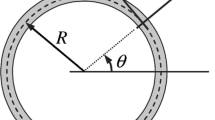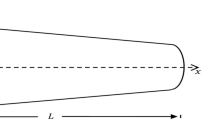Abstract
We show the importance of incorporating material nonlinearity for accurate determination of spatial buckling of nanorods and nanotubes. Both the nanorods and nanotubes are modeled as a special Cosserat rod whose nonlinear material laws are obtained using the recently proposed helical Cauchy-Born rule. We first present Euler buckling of solid diamond nanorods whose normalized buckling load, obtained from fully atomistic calculations, exhibits an interesting trend. The buckling load starts from unity at large aspect ratio of the nanorod, then as the aspect ratio is decreased, the buckling load increases slowly and finally decreases rapidly. We attribute this trend to material nonlinearity of the nanorod’s core at large compressive strain. We also discuss how surface stress affects buckling in nanorods. We then present the effect of compression and twist on buckling of single-walled carbon nanotubes. Interestingly, for highly twisted nanotubes, fully atomistic calculations show the first buckled mode to be different from a typical Euler buckling mode. Both the observations about nanorods and nanotubes are accurately replicated in the finite element special Cosserat rod simulation when the material nonlinearity is also incorporated. However, the simulation results exhibit completely different trend when only linear material laws are incorporated.

















Similar content being viewed by others
Notes
Throughout the paper, the differentiation of a field variable with respect to arc-length is denoted by a superscripted prime, i.e., \(\frac{d}{ds}\equiv(\cdot)^{ \prime}\).
The Einstein’s summation convention is implied unless stated. Repeated Latin indices always sum from 1 to 3 whereas repeated Greek indices sum from 1 to 2.
We refrain from calling the smallest repeating cell as “unit cell” since the nanorod does not retain translational periodicity when deformed. The generalization to the concept of fundamental domain was first proposed by James [18].
For detailed discussion on constraints, see the paragraph following Eq. (19) in Kumar et al. [22] and also Sect. 5.1 there which illustrates the role of constraints in imposing uniform bending-stretching deformation in a nanorod.
The stiffnesses have been normalized with their corresponding values in the stress-free state (at relaxation strain).
The “Young’s modulus” is defined as the second derivative of the diamond’s unit cell energy with respect to compression divided by the undeformed area of the unit cell’s face whose normal is along \([1\, 0\, 0]\) direction.
The stiffnesses in Fig. 9(a) are normalized by their continuum formulae for which we use bulk diamond’s Young’s and shear modulus in its stress-free state. Similarly the bulk elastic moduli are normalized by their respective values in the stress-free state.
Liang et al. [23] also reported the variation in the extensional stiffness for a copper nanowire to be largely due to nonlinear elasticity of the nanowire’s core.
The buckling load diagram similar to Fig. 11 were also presented in Fig. 9 in Kumar et al. [22]. The key differences here are: (i) the inclusion of buckling data corresponding to shell buckling mode to highlight the failure of rod model for hollow tubes at low aspect ratio and (ii) the aspect ratio being used here on the horizontal axis in order to facilitate its comparison with the solid diamond rod data from Fig. 9(b).
References
Antman, S.S.: Nonlinear Problems of Elasticity. Springer, New York (1995)
Arroyo, M., Belytschko, T.: An atomistic-based finite deformation membrane for single layer crystalline films. J. Mech. Phys. Solids 50, 1941–1977 (2002)
Bertails, F., Audoly, B., Cani, M.P., Querleux, B., Leroy, F., Lévêque, J.L.: Super-helices for predicting the dynamics of natural hair. ACM Trans. Graph. 25, 1180–1187 (2006)
Bozec, L., van der Heijden, G., Horton, M.: Collagen fibrils: nanoscale ropes. Biophys. J. 92, 70–75 (2007)
Brenner, D.W.: Empirical potential for hydrocarbons for use in simulating the chemical vapor deposition of diamond films. Phys. Rev. B 42, 9458 (1990)
Buehler, M., Kong, Y., Gao, H.: Deformation mechanisms of very long single-wall carbon nanotubes subject to compressive loading. J. Eng. Mater. Technol. 126, 245–249 (2004)
Chandraseker, K., Mukherjee, S., Paci, J.T., Schatz, G.C.: An atomistic-continuum Cosserat rod model of carbon nanotubes. J. Mech. Phys. Solids 57, 932–958 (2009)
Cowper, G.R.: The shear coefficient in Timoshenko’s beam theory. J. Appl. Mech. 33, 335–340 (1966)
Cuenot, S., Frétigny, C., Demoustier-Champagne, S., Nysten, B.: Surface tension effect on the mechanical properties of nanomaterials measured by atomic force microscopy. Phys. Rev. B 69, 165410 (2004)
Fang, C., Kumar, A., Mukherjee, S.: Finite element analysis of carbon nanotubes based on a rod model including in-plane cross-sectional deformation. Int. J. Solids Struct. 50, 49–56 (2013)
Goriely, A., Tabor, M.: Spontaneous helix hand reversal and tendril perversion in climbing plants. Phys. Rev. Lett. 80, 1564 (1998)
Gould, T., Burton, D.A.: A Cosserat rod model with microstructure. New J. Phys. 8, 1–17 (2006)
Goyal, S., Perkins, N.C., Lee, C.L.: Non-linear dynamic intertwining of rods with self-contact. Int. J. Non-Linear Mech. 43, 65–73 (2008)
Gurtin, M.E., Murdoch, A.I.: A continuum theory of elastic material surfaces. Arch. Ration. Mech. Anal. 57, 291–323 (1975)
Hakobyan, Ye., Tadmor, E.B., James, R.D.: Objective quasicontinuum approach for rod problems. Phys. Rev. B 86, 245435 (2012)
Healey, T.J.: Material symmetry and chirality in nonlinearly elastic rods. Math. Mech. Solids 7, 405–420 (2002)
Healey, T.J., Papadopoulos, C.M.: Bifurcation of hemitropic elastic rods under axial thrust. Q. Appl. Math. 71, 729–753 (2013)
James, R.D.: Objective structures. J. Mech. Phys. Solids 54, 2354–2390 (2006)
Jing, G.Y., Duan, H., Sun, X.M., Zhang, Z.S., Xu, J., Li, Y.D., Wang, J.X., Yu, D.P.: Surface effects on elastic properties of silver nanowires: contact atomic-force microscopy. Phys. Rev. B 73, 235409 (2006)
Kumar, A., Healey, T.J.: A generalized computational approach to stability of static equilibria of nonlinearly elastic rods in the presence of constraints. Comput. Methods Appl. Mech. Eng. 199, 1805–1815 (2010)
Kumar, A., Mukherjee, S., Paci, J.T., Chandraseker, K., Schatz, G.C.: A rod model for three dimensional deformations of single-walled carbon nanotubes. Int. J. Solids Struct. 48, 2849–2858 (2011)
Kumar, A., Kumar, S., Gupta, P.: A helical Cauchy-Born rule for special Cosserat rod modeling of nano and continuum rods. J. Elast. 124, 81–106 (2016)
Liang, H., Upamanyu, M., Huang, H.: Size dependent elasticity of nanowires: nonlinear effects. Phys. Rev. B 71, 241403 (2005)
Liew, K.M., Wong, C.H., He, X.Q., Tan, M.J., Meguid, S.A.: Nanomechanics of single and multiwalled carbon nanotubes. Phys. Rev. B 69, 115429 (2004)
Liu, J., Huang, J., Su, T., Bertoldi, K., Clarke, D.R.: Structural transition from helices to hemihelices. PLoS ONE 9, e93183 (2014)
Manning, R.S., Maddocks, J.H., Kahn, J.D.: A continuum rod model of sequence-dependent DNA structure. J. Chem. Phys. 105, 5626 (1996)
Miller, R., Shenoy, V.B.: Size-dependent elastic properties of nano-sized structural elements. Nanotechnology 11, 139–147 (2000)
On, B.B., Altus, E., Tadmor, E.B.: Surface effects in non-uniform nanobeams: continuum vs. atomistic modeling. Int. J. Solids Struct. 47, 1243–1252 (2010)
Pantano, A., Boyce, M.C., Parks, D.M.: Nonlinear structural mechanics based modeling of carbon nanotube deformation. Phys. Rev. Lett. 91, 145504 (2003)
Park, H.S.: Surface stress effects on the critical buckling strains of silicon nanowires. Compos. Mater. Sci. 51, 396–401 (2012)
Park, H.S., Klein, P.A., Wagner, G.J.: A surface Cauchy-Born model for nanoscale materials. Int. J. Numer. Methods Eng. 68, 1072–1095 (2006)
Shenoy, V.B.: Atomistic calculations of elastic properties of metallic fcc crystal surfaces. Phys. Rev. B 71, 094104 (2005)
Tang, W., Lagadec, P., Gould, D., Wan, T.R., Zhai, J., How, T.: A realistic elastic rod model for real-time simulation of minimally invasive vascular interventions. Vis. Comput. 26, 1157–1165 (2010)
Wang, G.F., Feng, X.Q.: Surface effects on buckling of nanowires under uniaxial compression. Appl. Phys. Lett. 94, 141913 (2009)
Wang, G.F., Feng, X.Q.: Timoshenko beam model for buckling and vibration of nanowires with surface effects. J. Phys. D, Appl. Phys. 42, 155411 (2009)
Wang, M.D., Yin, H., Landick, R., Gelles, J., Block, S.M.: Stretching DNA with optical tweezers. Biophys. J. 72, 1335–1346 (1997)
Wong, E.W., Sheehan, P.E., Lieber, C.M.: Nanobeam mechanics: elasticity, strength, and toughness of nanorods and nanotubes. Science 277, 1971–1975 (1997)
Yakobson, B.I., Brabec, C.J., Bernholc, J.: Nanomechanics of carbon tubes: instabilities beyond linear response. Phys. Rev. Lett. 76(14), 2511 (1996)
Acknowledgements
P. Gupta acknowledges the financial support received from DST-INSPIRE fellowship and A. Kumar acknowledges the support from SERB, India through the grant YSS/2014/000023.
Author information
Authors and Affiliations
Corresponding author
Rights and permissions
About this article
Cite this article
Gupta, P., Kumar, A. Effect of Material Nonlinearity on Spatial Buckling of Nanorods and Nanotubes. J Elast 126, 155–171 (2017). https://doi.org/10.1007/s10659-016-9586-1
Received:
Published:
Issue Date:
DOI: https://doi.org/10.1007/s10659-016-9586-1




